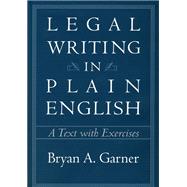
| Preface | xiii | ||||
| Introduction | xvii | ||||
| PART ONE: Principles For All Legal Writing | 1 | (2) | |||
| 1. Framing Your Thoughts | 3 | (14) | |||
|
3 | (2) | |||
|
5 | (5) | |||
|
10 | (4) | |||
|
14 | (3) | |||
| 2. Phrasing Your Sentences | 17 | (17) | |||
|
17 | (2) | |||
|
19 | (4) | |||
|
23 | (1) | |||
|
24 | (4) | |||
|
28 | (2) | |||
|
30 | (1) | |||
|
31 | (3) | |||
| 3. Choosing Your Words | 34 | (19) | |||
|
34 | (3) | |||
|
37 | (1) | |||
|
38 | (2) | |||
|
40 | (3) | |||
|
43 | (1) | |||
|
44 | (1) | |||
|
45 | (2) | |||
|
47 | (1) | |||
|
48 | (5) | |||
| PART TWO: Principles Mainly For Analytical And Persuasive Writing | 53 | (36) | |||
|
55 | (3) | |||
|
58 | (4) | |||
|
62 | (3) | |||
|
65 | (2) | |||
|
67 | (5) | |||
|
72 | (3) | |||
|
75 | (2) | |||
|
77 | (6) | |||
|
83 | (2) | |||
|
85 | (4) | |||
| PART THREE: Principles Mainly For Legal Drafting | 89 | (32) | |||
|
91 | (2) | |||
|
93 | (4) | |||
|
97 | (3) | |||
|
100 | (5) | |||
|
105 | (2) | |||
|
107 | (5) | |||
|
112 | (2) | |||
|
114 | (1) | |||
|
115 | (2) | |||
|
117 | (4) | |||
| PART FOUR: Principles For Document Design | 121 | (14) | |||
|
123 | (1) | |||
|
124 | (1) | |||
|
125 | (1) | |||
|
126 | (1) | |||
|
127 | (8) | |||
| PART FIVE: Methods For Continued Improvement | 135 | (12) | |||
|
137 | (1) | |||
|
138 | (2) | |||
|
140 | (3) | |||
|
143 | (2) | |||
|
145 | (2) | |||
| Appendix A How to Punctuate | 147 | (17) | |||
| Appendix B Four Model Documents | 164 | (43) | |||
|
165 | (8) | |||
|
173 | (9) | |||
|
182 | (14) | |||
|
196 | (11) | |||
| Key to Basic Exercises | 207 | (16) | |||
| Index | 223 |
The New copy of this book will include any supplemental materials advertised. Please check the title of the book to determine if it should include any access cards, study guides, lab manuals, CDs, etc.
The Used, Rental and eBook copies of this book are not guaranteed to include any supplemental materials. Typically, only the book itself is included. This is true even if the title states it includes any access cards, study guides, lab manuals, CDs, etc.